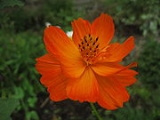
Cosmos sulphureus
Encyclopedia
Cosmos sulphureus is also known as Sulfur Cosmos and Yellow Cosmos. Its native habitat is Central America
.
This species of Cosmos is considered a half-hardy annual
, although plants may re-appear via self-sowing for several years. Its foliage is opposite and pinnately divided. The plant height varies from one to seven feet. The original and its cultivars appear in shades of yellow, orange, and red. It is especially popular in Korea
and Japan
, where it is often seen in mass plantings along roadsides, following an initiative pursued by the Korean-Japanese botanist Woo Jang-choon
.
This plant was declared invasive
by the United States Southeast Exotic Pest Plant Council in 1996 .
Some of the varieties of Cosmos sulphureus in cultivation today include:
Growth characteristics of this plant include:
The flowers of all Cosmos attract birds and butterflies, including the Monarch butterfly
. Cosmos sulphureus is featured in the 1997 Japanese film Remembering the Cosmos Flower
.
Central America
Central America is the central geographic region of the Americas. It is the southernmost, isthmian portion of the North American continent, which connects with South America on the southeast. When considered part of the unified continental model, it is considered a subcontinent...
.
This species of Cosmos is considered a half-hardy annual
Annual plant
An annual plant is a plant that usually germinates, flowers, and dies in a year or season. True annuals will only live longer than a year if they are prevented from setting seed...
, although plants may re-appear via self-sowing for several years. Its foliage is opposite and pinnately divided. The plant height varies from one to seven feet. The original and its cultivars appear in shades of yellow, orange, and red. It is especially popular in Korea
Korea
Korea ) is an East Asian geographic region that is currently divided into two separate sovereign states — North Korea and South Korea. Located on the Korean Peninsula, Korea is bordered by the People's Republic of China to the northwest, Russia to the northeast, and is separated from Japan to the...
and Japan
Japan
Japan is an island nation in East Asia. Located in the Pacific Ocean, it lies to the east of the Sea of Japan, China, North Korea, South Korea and Russia, stretching from the Sea of Okhotsk in the north to the East China Sea and Taiwan in the south...
, where it is often seen in mass plantings along roadsides, following an initiative pursued by the Korean-Japanese botanist Woo Jang-choon
Woo Jang-choon
Woo Jang-choon was a Korean-Japanese agricultural scientist and botanist famous for breeding plants. He preferred U and published his paper with this family name....
.
This plant was declared invasive
Invasive species
"Invasive species", or invasive exotics, is a nomenclature term and categorization phrase used for flora and fauna, and for specific restoration-preservation processes in native habitats, with several definitions....
by the United States Southeast Exotic Pest Plant Council in 1996 .
Some of the varieties of Cosmos sulphureus in cultivation today include:
- 'Klondyke Mix' consists of a variety of colors in shades from yellow to orange and scarlet
- 'Ladybird Dwarf Red', 'Ladybird Dwarf Gold', 'Ladybird Dwarf Orange', and 'Ladybird Dwarf Lemon' are shorter than the species. Another cultivar is named "Bright Eyes".
Growth characteristics of this plant include:
- GerminationGerminationGermination is the process in which a plant or fungus emerges from a seed or spore, respectively, and begins growth. The most common example of germination is the sprouting of a seedling from a seed of an angiosperm or gymnosperm. However the growth of a sporeling from a spore, for example the...
takes between 7 and 21 days at the optimal temperature of 75 degrees Fahrenheit; flowering begins between 50 and 60 days after germination - It prefers a soil pHPHIn chemistry, pH is a measure of the acidity or basicity of an aqueous solution. Pure water is said to be neutral, with a pH close to 7.0 at . Solutions with a pH less than 7 are said to be acidic and solutions with a pH greater than 7 are basic or alkaline...
between 6.0 and 8.5, reflecting its native habitat in the alkaline regions of Central AmericaCentral AmericaCentral America is the central geographic region of the Americas. It is the southernmost, isthmian portion of the North American continent, which connects with South America on the southeast. When considered part of the unified continental model, it is considered a subcontinent... - Flowering is best in full sun, although partial shade is tolerated
- The plant is tolerant to drought after germination, and is seldom subject to insect or disease damage; this vigor is attested by its status as a pest in some areas of the United States
The flowers of all Cosmos attract birds and butterflies, including the Monarch butterfly
Monarch butterfly
The Monarch butterfly is a milkweed butterfly , in the family Nymphalidae. It is perhaps the best known of all North American butterflies. Since the 19th century, it has been found in New Zealand, and in Australia since 1871 where it is called the Wanderer...
. Cosmos sulphureus is featured in the 1997 Japanese film Remembering the Cosmos Flower
Remembering the Cosmos Flower
is a 1997 Japanese movie directed by Junichi Suzuki. It is the story of a Japanese girl returning to Japan after seven years in South America where she contracted AIDS....
.

